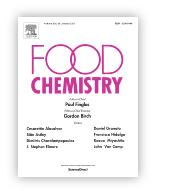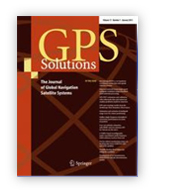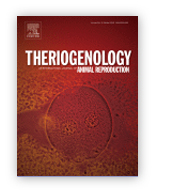Anti-diabetic, anti-cholinesterase, and antioxidant potential, chemical composition and sensory evaluation of novel sea buckthorn-based smoothies
Karolina Tkacz, Aneta Wojdyło, Igor Turkiewicz, Paulina Nowicka
Food Chemistry
 Sea buckthorn berries fit into the strategy of seeking natural factors in the non-communicable diseases pre-vention, but their sensory qualities are a challenge for consumers and food industry. The study aimed to evaluate anti-cholinesterase (anti-acetylcholinesterase and -butylcholinesterase), anti-diabetic (anti-α-amylase, -α-gluco-sidase, -pancreatic lipase) and antioxidant potential (FRAP, ORAC), phenolic compounds (UPLC-PDA-FL), basic chemical composition, and sensory quality of sea buckthorn-based smoothies. Eighteen novel products con-taining sea buckthorn (25–50%) with other fruits and vegetables were analyzed. Sea buckthorn enriched the smoothies in flavonols (25.46–95.13 mg/100 g), and fruits and vegetables provided phenolic acids and pro-cyanidins. The anti-BuChE effect was higher than anti-AChE, while products with apricot, orange, grape and parsley root were strong inhibitors of carbohydrates digesting enzymes. Lipase inhibition by all smoothies was over 50%. Products with 75% fruits or 50% vegetables were the most sensory attractive. The results will be valuable in designing innovative food with rarely used berries.
Sea buckthorn berries fit into the strategy of seeking natural factors in the non-communicable diseases pre-vention, but their sensory qualities are a challenge for consumers and food industry. The study aimed to evaluate anti-cholinesterase (anti-acetylcholinesterase and -butylcholinesterase), anti-diabetic (anti-α-amylase, -α-gluco-sidase, -pancreatic lipase) and antioxidant potential (FRAP, ORAC), phenolic compounds (UPLC-PDA-FL), basic chemical composition, and sensory quality of sea buckthorn-based smoothies. Eighteen novel products con-taining sea buckthorn (25–50%) with other fruits and vegetables were analyzed. Sea buckthorn enriched the smoothies in flavonols (25.46–95.13 mg/100 g), and fruits and vegetables provided phenolic acids and pro-cyanidins. The anti-BuChE effect was higher than anti-AChE, while products with apricot, orange, grape and parsley root were strong inhibitors of carbohydrates digesting enzymes. Lipase inhibition by all smoothies was over 50%. Products with 75% fruits or 50% vegetables were the most sensory attractive. The results will be valuable in designing innovative food with rarely used berries.
10.1016/j.foodchem.2020.128105
Geocenter coordinates derived from multi-GNSS: a look into the role of solar radiation pressure modeling
Radosław Zajdel, Krzysztof Sośnica, Grzegorz Bury
GPS Solutions
 The Global Navigational Satellite System (GNSS) technique is naturally sensitive to the geocenter motion, similar to all satellite techniques. However, the GNSS-based estimates of the geocenter used to contain more orbital artifacts than the geophysical signals, especially for the Z component of the geocenter coordinates. This contribution conveys a discussion on the impact of solar radiation pressure (SRP) modeling on the geocenter motion estimates. To that end, we process 3 years of GPS, GLONASS, and Galileo observations (2017–2019), collected by a globally distributed network of the ground stations. All possible individual system-specific solutions, as well as combinations of the available constellations, are tested in search of characteristic patterns in geocenter coordinates. We show that the addition of a priori information about the SRP-based forces acting on the satellites using a box-wing model mitigates a great majority of the spurious signals in the spectra of the geocenter coordinates. The amplitude of the 3 cpy (about 121 days) signal for GLONASS has been reduced by a factor of 8.5. Moreover, the amplitude of the spurious 7 cpy (about 52 days) signal has been reduced by a factor of 5.8 and 3.1 for Galileo and GPS, respectively. Conversely, the box-wing solutions indicate increased amplitudes of the annual variations in the geocenter signal. The latter reaches the level of 10–11 mm compared to 4.4 and 6.0 mm from the satellite laser ranging observations of LAGEOS satellites and the corresponding GNSS series applying extended empirical CODE orbit model (ECOM2), respectively. Despite the possible improvement in the GLONASS-based Z component of the geocenter coordinates, we show that some significant power can still be found at periods other than annual. The GPS- and Galileo-based estimates are less affected; thus, a combination of GPS and Galileo leads to the best geocenter estimates.
The Global Navigational Satellite System (GNSS) technique is naturally sensitive to the geocenter motion, similar to all satellite techniques. However, the GNSS-based estimates of the geocenter used to contain more orbital artifacts than the geophysical signals, especially for the Z component of the geocenter coordinates. This contribution conveys a discussion on the impact of solar radiation pressure (SRP) modeling on the geocenter motion estimates. To that end, we process 3 years of GPS, GLONASS, and Galileo observations (2017–2019), collected by a globally distributed network of the ground stations. All possible individual system-specific solutions, as well as combinations of the available constellations, are tested in search of characteristic patterns in geocenter coordinates. We show that the addition of a priori information about the SRP-based forces acting on the satellites using a box-wing model mitigates a great majority of the spurious signals in the spectra of the geocenter coordinates. The amplitude of the 3 cpy (about 121 days) signal for GLONASS has been reduced by a factor of 8.5. Moreover, the amplitude of the spurious 7 cpy (about 52 days) signal has been reduced by a factor of 5.8 and 3.1 for Galileo and GPS, respectively. Conversely, the box-wing solutions indicate increased amplitudes of the annual variations in the geocenter signal. The latter reaches the level of 10–11 mm compared to 4.4 and 6.0 mm from the satellite laser ranging observations of LAGEOS satellites and the corresponding GNSS series applying extended empirical CODE orbit model (ECOM2), respectively. Despite the possible improvement in the GLONASS-based Z component of the geocenter coordinates, we show that some significant power can still be found at periods other than annual. The GPS- and Galileo-based estimates are less affected; thus, a combination of GPS and Galileo leads to the best geocenter estimates.
10.1007/s10291-020-01037-3
The frequency of collapse as a predictor of feline blastocyst quality
Barbara Kij, Joanna Kochan, Karolina Fryc, Wojciech Niżański, Sylwia Prochowska, Julia Gabryś, Agnieszka Nowak, Monika Bugno-Poniewierska
Theriogenology
 Domestic cats are frequently used as a research model for felid species that are threatened withextinction. Until now, the development of feline embryos has been evaluated using both classicalobservation methods and time-lapse monitoring (TLM). Blastocyst collapse observed using time-lapsecinematography is used as a predictor of blastocyst quality and is closely related to implantation po-tential. The aim of this study was to determine the relationship between the quality of domestic catblastocysts obtained afterin vitrofertilization and the frequency and duration of collapse, and ofhatching.There was a significant difference in the average number of collapses and weak contractions betweengood and poor quality blastocysts. There was no significant difference between hatching and non-hatching blastocysts in terms of blastocyst cavity formation time or average number and duration ofcollapse.These results showed that the time of cavity formation was not related to blastocyst quality. Thenumber of collapses and the occurrence of hatching were positively related to blastocyst quality, andpoor quality blastocysts have, as a consequence, a reduced potential for implantation. TLM plays a sig-nificant role in cat embryo evaluation.
Domestic cats are frequently used as a research model for felid species that are threatened withextinction. Until now, the development of feline embryos has been evaluated using both classicalobservation methods and time-lapse monitoring (TLM). Blastocyst collapse observed using time-lapsecinematography is used as a predictor of blastocyst quality and is closely related to implantation po-tential. The aim of this study was to determine the relationship between the quality of domestic catblastocysts obtained afterin vitrofertilization and the frequency and duration of collapse, and ofhatching.There was a significant difference in the average number of collapses and weak contractions betweengood and poor quality blastocysts. There was no significant difference between hatching and non-hatching blastocysts in terms of blastocyst cavity formation time or average number and duration ofcollapse.These results showed that the time of cavity formation was not related to blastocyst quality. Thenumber of collapses and the occurrence of hatching were positively related to blastocyst quality, andpoor quality blastocysts have, as a consequence, a reduced potential for implantation. TLM plays a sig-nificant role in cat embryo evaluation.
10.1016/j.theriogenology.2020.08.008









